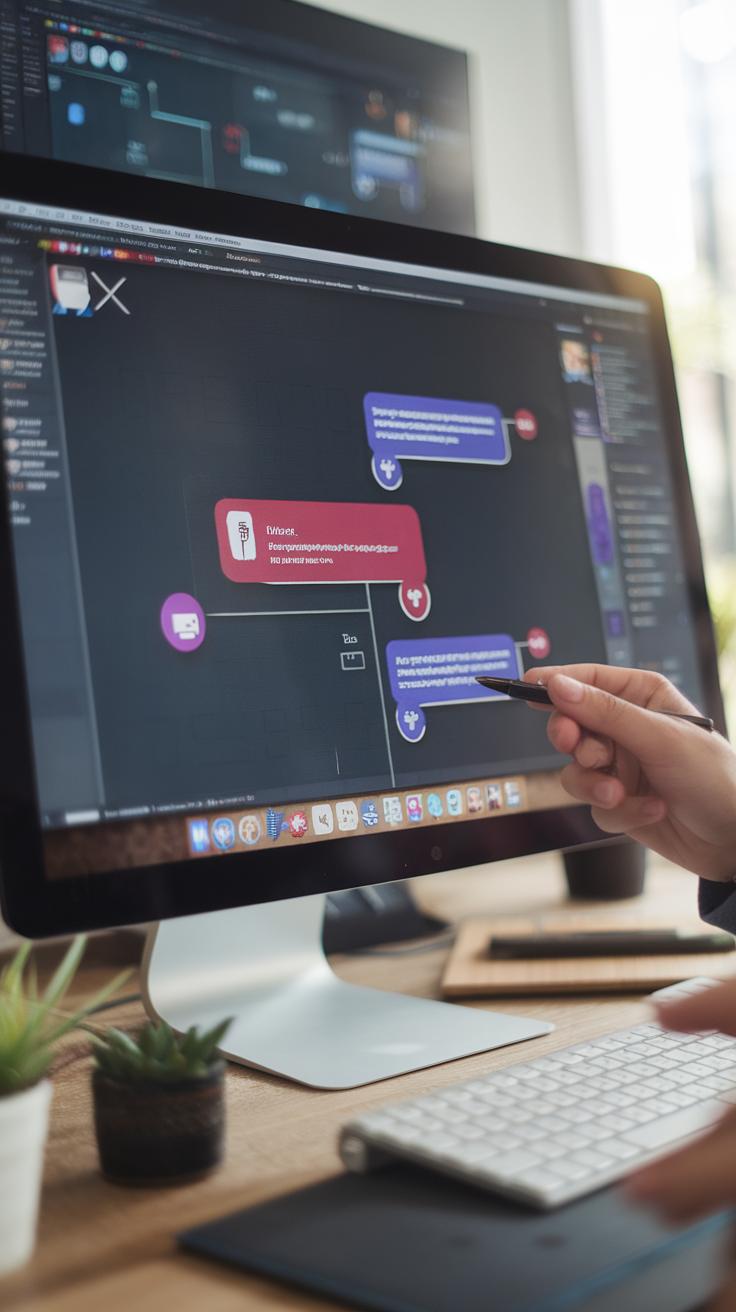Introduction
In an increasingly digital world, engaging users in real-time has become a crucial strategy for businesses aiming to build strong customer relationships. Real-time engagement refers to the ability to connect with users instantly, offering timely information and support. One of the most effective tools for achieving this is a free website chat widget, which allows businesses to interact with visitors, answer queries, and provide assistance on demand. By harnessing the power of real-time communication, companies can significantly enhance the overall user experience, driving conversions and fostering loyalty.
This article explores various strategies to maximize the effectiveness of free website chat widgets. From optimizing widget placement to crafting engaging conversations, we will delve into actionable insights that can help organizations leverage real-time engagement to their advantage. Engaging users as they navigate through websites not only increases the chances of conversion but also contributes to an overall positive perception of the brand. As we progress through the chapters, we will uncover practical tactics for successful implementation and continuous improvement of chat engagement strategies.
Understanding RealTime Engagement The Key to Enhanced Digital Communication
Defining Real-Time Engagement
Real-time engagement refers to the instantaneous interaction between businesses and their audiences through digital platforms. This practice has transformed how companies connect with customers, enabling them to provide immediate assistance, gather feedback, and enhance overall user experiences. As communication technologies have advanced, the potential for real-time engagement has significantly increased, propelling businesses to adopt more dynamic communication strategies.
The Importance of Real-Time Engagement
The significance of real-time engagement cannot be overstated. In a world where consumers expect prompt answers, businesses can no longer afford to delay responses or rely solely on asynchronous communication methods. Real-time interactions can lead to higher customer satisfaction, increased conversion rates, and the building of robust relationships. For instance, chat widgets on websites empower visitors to receive quick answers while browsing, alleviating frustration and fostering a sense of care and attentiveness from the brand.
Moreover, real-time engagement contributes to the overall brand perception. Companies that actively engage with their customers in the moment establish a reputation for responsiveness and quality service. This reputation extends beyond individual interactions; it influences long-term loyalty, encouraging customers to return and recommend the brand to others. In a competitive landscape, where user experience serves as a differentiator, effective real-time engagement is vital for business growth.
The Evolution of Real-Time Engagement Technology
Technological advancements have substantially shaped the landscape of real-time engagement. Early methods of communication included emails and message boards, which were often plagued by delays. However, the advent of online messaging, social media, and chat functionalities has revolutionized user interactions. Companies now utilize chatbots powered by artificial intelligence to manage customer inquiries 24/7, freeing up human representatives for more complex issues.
The integration of analytics tools has enhanced real-time engagement by allowing organizations to track user behavior and preferences. This data-driven approach enables businesses to tailor interactions, offering personalized experiences that cater to individual user needs. With these technological innovations at their disposal, companies can proactively engage users, predicting queries and addressing them before they escalate into larger concerns.
Implementing a Free Website Chat Widget for RealTime Engagement Success
Step-by-Step Guide to Selection and Implementation
Integrating a free website chat widget involves a series of thoughtful steps designed to enhance real-time engagement. The initial stage is the selection of the right chat widget that aligns with your website’s goals and user expectations. Evaluate various options by reviewing features such as customization, ease of use, and integration capabilities. Popular choices include Tawk.to, Drift, and Crisp, all of which offer lightweight installations and user-friendly interfaces.
Consider the specific needs of your audience. An effective chat widget should not only cater to your business’s requirements but also resonate with the users’ preferences. Look for widgets that support multiple languages, mobile responsiveness, and can be integrated seamlessly with your current customer management systems. Compare user ratings and feedback to get a sense of what works best in real-world scenarios.
Once a chat widget has been selected, the next phase is implementation. Most free chat widgets provide detailed installation instructions, often requiring just a simple copy-and-paste of JavaScript code into your website’s HTML. Aim to place the widget in a frequently visited section of your site, ensuring easy accessibility for users seeking assistance. Follow the documentation closely to avoid issues during installation.
After installation, customize the chat widget to reflect your brand identity. This includes adjusting colors, logos, and greetings. A personalized touch can enhance engagement, making users feel valued right from their first interaction. Additionally, consider setting automated responses for frequently asked questions to ensure users receive immediate assistance, even when human agents are unavailable.
Monitor interactions post-implementation. Analyzing user engagement metrics will provide insights into chat performance and areas for improvement. Implement tools to measure metrics such as response time, visitor satisfaction, and conversion rates. Regularly refine your widget based on user feedback and engagement trends to ensure it remains a valuable asset that enhances real-time engagement on your platform.
Best Practices for Ongoing Management
Managing your chat widget effectively involves ongoing optimization. Provide training for your team to ensure they can leverage the chat tool efficiently. Moreover, encourage team members to actively participate in chat interactions, fostering a more humanized engagement approach. Regular updates to the chat functionality can also enhance user experience, making interactions smoother and more effective.
By selecting a suitable chat widget, implementing it correctly, and maintaining it with care, businesses can enjoy enhanced real-time engagement and provide a much-improved online user experience.
Optimizing Placement for Maximum Engagement
Strategic Widget Positioning
Effective placement of a chat widget is fundamental to enhancing real-time engagement on your website. The goal is to ensure visibility without being intrusive. A well-placed widget can create more meaningful interactions with users who may have questions or need support. By considering user behavior and routines, you can optimize your chat widget’s placement significantly.
Placing the chat widget in the bottom-right corner of the screen results in higher engagement rates. This position captures users’ attention as they typically navigate towards this area after reading content. A widget that slides into view rather than appearing suddenly can mitigate any feeling of disruption for the user. On the contrary, avoiding placement in areas that may block crucial content is vital.
Utilizing Timing and Triggers
Timing is equally important when it comes to chat widget engagement. Using time-based triggers enables you to present the chat option at moments when users are most likely to engage. For instance, if a user spends over 30 seconds on a specific page, this could indicate that they might have questions. A timed prompt inviting them to chat can enhance their experience, making them feel supported and seen.
Implementing exit-intent technology is another effective strategy. This means prompting a chat invitation as a user’s mouse moves toward the browser’s exit button. A friendly message, such as “Need assistance before you go?” can encourage interaction and potentially convert a lost visitor into a lead.
Mobile Optimization
Given the increase in mobile web traffic, optimizing chat widget placement for mobile users is essential. On mobile devices, consider a floating button that remains accessible as users scroll through your site. This ensures that users can easily reach out without experiencing disruptions. Clustered elements can lead to an overwhelming interface, so maintaining clarity while positioning the widget is crucial.
Conducting A/B tests to determine the most effective placement strategies on both desktop and mobile versions of the site can provide valuable insights. Evaluating user feedback and engagement metrics will assist in fine-tuning your approach, ultimately leading to improved real-time user interactions and enhanced online experiences.
Crafting Engaging Chat Conversations Techniques for RealTime User Interactions
Crafting interactive and meaningful conversations through the chat widget is paramount for a successful online experience. To foster engagement, it is key to understand user intent and tailor conversations accordingly. This involves active listening, asking open-ended questions, and providing relevant responses that resonate with users.
Creating Meaningful Dialogue
A fundamental technique for creating engaging conversations is to focus on user-centric dialogue. Start by employing the right tone and language that aligns with your brand while remaining relatable to users. Using friendly, conversational language invites users to participate and feel comfortable. Additionally, leveraging users’ names during interactions can personalize the experience, making them feel valued and recognized.
When responding to queries, be sure to actively listen to the user’s concern. Reflect back key aspects of their inquiry in your responses, showing that you understand and are engaged with their needs. This practice not only builds rapport but also encourages users to elaborate on their concerns, leading to a more productive discussion.
Utilizing Proactive Engagement Techniques
Proactive engagement techniques can drastically enhance the chat conversation. Instead of waiting for users to initiate a chat, consider deploying proactive chat prompts based on user behavior. For instance, if a visitor lingers on a product page, a prompt could appear offering assistance or additional information about the product. This tactic demonstrates attentiveness to their journey, leading to increased interaction chances.
Using chatbots to handle frequently asked questions or guide users through simple tasks can enhance efficiency. These bots supply quick answers while human representatives can focus on complex queries, ensuring messages are not lost while users await assistance. This combination not only streamlines communication but supports a knowledgeable assistant-like feel throughout the engagement.
Incorporating multimedia elements within the chat can make interactions more lively. Utilize images, GIFs, or quick links to resources as part of your responses, enriching the user experience and providing clarity on complicated subjects. By making interactions engaging and visually appealing, users are more likely to stay engaged and return for future interactions.
As you refine your engagement strategies, remember that continuous improvement is vital. Always be ready to adapt your techniques based on feedback, user behavior, and emerging trends, paving the way for exceptional chat experiences and user satisfaction.
Analyzing Chat Engagement Metrics for Real Time Engagement Strategies
Understanding Key Metrics
To gauge the success of your real-time interactions through a website chat widget, it is vital to analyze the metrics that reflect user engagement. Key metrics to monitor include number of chat initiations, response time, chat duration, and user satisfaction ratings. These metrics provide insight into how effectively the chat widget is facilitating conversations and addressing user inquiries.
The number of chat initiations helps you understand the volume of user interactions. A high number signifies that users are willing to engage, indicating that your website is attracting the right audience. Conversely, if the number is low, this may suggest that chat widgets are either not noticeable or users do not perceive value in initiating a conversation.
Response time is another crucial metric. Quick responses support user engagement and indicate that your team or chat automation system is functioning efficiently. In contrast, prolonged wait times can lead to frustration and abandonment, negatively impacting user experience.
Assessing Interaction Quality
Besides quantitative metrics, quality aspects of chat interactions deserve attention. Chat duration can reflect the depth of the conversation. Shorter chats may suggest effective problem-solving, while excessively long interactions could indicate that users are struggling to get the information they need, highlighting the need for improved content or responses.
User satisfaction ratings, often gathered through post-chat surveys, provide valuable qualitative data. High ratings generally suggest that users found the engagement fruitful, corroborating the effectiveness of chat strategies. Low satisfaction scores can signal areas needing improvement, such as response accuracy or relevance.
Segmenting data based on user demographics or behavioral patterns can yield further insights. Understanding different segments’ engagement levels helps tailor chat widget features and conversational strategies to meet varied user needs. For instance, if older demographics show less engagement, consider adjusting the interface for enhanced usability or providing more informative initiation prompts.
Continuous monitoring and analysis of these metrics empower businesses to refine their real-time engagement efforts. By leveraging data, organizations can ensure their chat widget evolves to meet user expectations and enhances the overall online experience.
Integrating Chat Widgets with Other Tools Enhancing RealTime Engagement Strategies
Maximizing Benefits through Integration
Integrating chat widgets with Customer Relationship Management (CRM) systems and other essential business tools can significantly enhance real-time user interactions. By creating a seamless flow of information between the chat widget and CRM, businesses can ensure more personalized and effective customer interactions. When inquiries and communication history are readily available at agents’ fingertips, it allows for a quicker response to customer needs, leading to improved satisfaction and engagement.
One of the primary advantages of this integration is the capability to maintain a holistic view of the customer journey. Chat widgets can capture interaction data, which can then be fed directly into a CRM system. This allows businesses to track not only immediate chat interactions but also long-term customer behavior. Marketing campaigns can be tailored based on insights gained from chat transcripts, thereby creating a more tailored marketing approach that resonates with customers on a personal level.
Utilizing chat widgets in conjunction with sales tools can also yield substantial benefits. For instance, when sales agents receive real-time notifications about customer inquiries, they can act promptly, potentially converting a casual browser into a paying customer. This immediate access to user data encourages proactive engagement, a critical component in today’s fast-paced online environment.
Streamlining Operations through Comprehensive Integration
The integration of chat widgets with other business tools also streamlines operations. With features such as chatbots that can handle common inquiries, human agents can focus on more complex issues. This layered approach effectively reduces wait times and increases the number of customer interactions handled, promoting higher engagement rates. Not only does this efficiency improve customer experiences, but it also leads to better resource allocation within the organization.
Integrating chat widgets with analytics tools allows businesses to measure the effectiveness of their customer engagement strategies in real-time. Data collected from these interactions can be analyzed to identify patterns and trends, helping businesses refine their real-time engagement strategies continually. By accessing this data, companies can ensure that they remain responsive to customer needs and preferences.
This multi-tool synergy not only improves customer satisfaction but also enables businesses to adapt quickly to changing market dynamics, setting them up for future success.
Future Trends in Real Time Engagement Analyzing Emerging Trends in RealTime Engagement
As digital communication continues to evolve, real-time engagement is poised for significant transformation. Emerging technologies are reshaping how businesses interact with their customers, especially through tools like chat widgets. A few key trends are shaping this future landscape.
Impact of Artificial Intelligence on Chat Interactions
Artificial intelligence (AI) is no longer a futuristic concept; it is a driving force behind improved chat interactions. Natural language processing (NLP) and machine learning algorithms are becoming increasingly sophisticated, allowing chat widgets to offer personalized user experiences. For instance, AI can analyze customer behavior in real time, enabling chatbots to respond with contextually relevant information tailored to user preferences.
This capability not only enhances customer satisfaction but also streamlines operational efficiency by handling routine inquiries automatically. As AI continues to advance, we can expect more human-like interactions, fostering a genuine connection between businesses and users in real time.
Integration of Multichannel Communication
The future of real-time engagement will likely see a seamless integration of various communication channels. Users often switch between platforms—social media, email, and websites—creating the need for a consistent experience across all touchpoints. Chat widgets will evolve to become more than simple query responders; they will serve as hubs for communication, allowing users to initiate conversations on one platform and continue them on another without losing context.
Such cross-channel engagement will empower customers, providing them with the flexibility and convenience that modern consumers expect. Businesses that adapt to this trend will likely experience higher engagement rates and improved customer loyalty.
Enhanced Personalization Through Data Analytics
Data analytics will play a pivotal role in shaping the future of real-time engagement. By leveraging data collected during interactions, businesses can gain valuable insights into consumer behaviors and preferences. This information can be used not only to inform immediate engagement strategies but also to refine overall marketing tactics.
As predictive analytics becomes more sophisticated, chat interactions will anticipate customer needs, often before they explicitly express them. By creating a more proactive engagement model, businesses can improve customer experiences and drive conversions systematically.
The future of real-time engagement in chat interactions will be characterized by the integration of AI, multichannel communication, and data analytics. By embracing these trends, businesses can unlock new opportunities for enhanced user interactions, ensuring that they remain competitive in an increasingly interconnected digital landscape.
Conclusions
Real-time engagement through the use of a chat widget is not just a tool but a vital element in fostering stronger relationships with customers. Businesses that effectively utilize this technology can expect to see a measurable impact on customer satisfaction and retention. By providing instant support and information, companies can significantly enhance the user journey, making it easier for visitors to achieve their goals on the website.




















